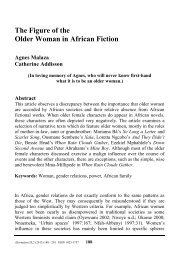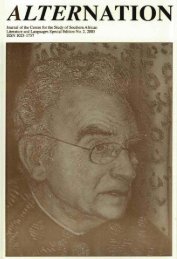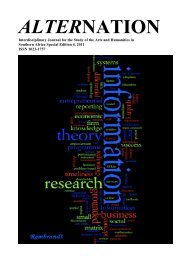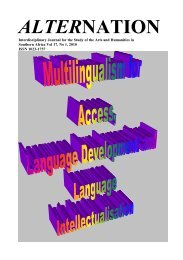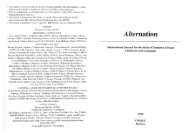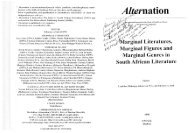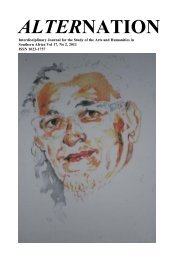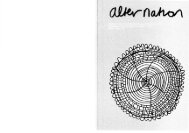Shane Moran - Alternation Journal
Shane Moran - Alternation Journal
Shane Moran - Alternation Journal
Create successful ePaper yourself
Turn your PDF publications into a flip-book with our unique Google optimized e-Paper software.
Corinne Sandwith Two Women Critics and South African English Literay Studies<br />
To teach people about democracy without changing society as a whole is to p<br />
sponding lack of critical attention". In a summary of English Marxism, Francis<br />
'cynics' and 'madmen' (194 1 i:9). Educational reforms, therefore, cannot take th<br />
em (1 974:40) argues that English Marxists<br />
ofgenuine efforts at social and economic redress.<br />
Turning to her literary criticism9, Taylor sets out her allegiances in<br />
following passage:<br />
were united in their insistence that literature could be understood only in<br />
relation to the social conditions in which it was produced. Hence. literary<br />
criticism came to be regarded as the elucidation of the social determinations<br />
The Marxist approach to art, in so far as it shows the relation betwcen art<br />
and society. in so far as it explains why and how a certain tendency in art has<br />
of a text, as the identification of the 'social equivalent' of a given character,<br />
sentiment or situation.<br />
arisen at a particular period in history, in so far as it assists the critic in<br />
analysing the individuality of the artist into its component elements, in so<br />
far as it is able to exainine critically the 'above the battle' attit~ide of both<br />
artists anti critics arid reveal Lhc social soots even of 'purc' art, is invaluable<br />
as a Incans for Inore fully Lindentanding the artist and for a more complete<br />
Taylor's criticism can also be broadly understood in these terms, she does not<br />
heir intellectual origins, claiming instead the intellectual and political tradition<br />
sic Marxism, which she received from Lenin and Trotsky. Unlike much of its<br />
cultural and political traditions, then, Taylor's strand of South African Marxism<br />
intcrnretatiotr ofart (l945b: 16).<br />
very little to ~ritain". In an article which appeared in University of Cape Town<br />
a1 The Crltic in 1935, Taylor (I 935:84-85) registers her indebtedness to the Lenln-<br />
\'he[ e Van Heynmgen looked to Ellglnr~d and I,cav15 for guidance, ljylor did not d sky heritage, and opposes the perversion of their ideals under Stalinist rule.<br />
In any g~eat ~neasr~le 1x1 Fngl~sh Marxists ol the 1930s"'. Ilescnbed ~ JJ Perry Andel<br />
i 1092 55) as d 'spol\taneouq rad~calisat~on v,~thm ttadrtlonally doimant mihe<br />
1 ngla\l-i Fdaruism was prlniarily a rcaclroil to the social, econornlc andpolrtrcal crr<br />
the pet iod, and it took it.; pol!t~cnl and thec~retical cue from Stalmtst Jiussid, rntlie<br />
C'er-it~~~l btirope Whereas thclte had been a trad~tlon oi M,.ilxr.;t thought tn (xeri<br />
iinl.c/ andkrance since the late eightecr.~th ccntury,<br />
Under the Sovret regrme art has become synoi~yn~ous wrth propaganda It<br />
was not so ~mmedrately after the revolutron In the first narve enthus~asm of<br />
the lrberated proletarrat forty thousand poets blossomed III Russla But<br />
when Staltn. In oppositron to Trotsky. turned the Russ~an Communrst Party<br />
Into a nattonalrst organrsat~on su~rounded by a hosttle Europe. 11 was<br />
necessary to create weapons of defence not only In Iron and steel, but In<br />
In/o iomparablc loin1 her~tdg~ \id\ ii~dildi)le lo th(: rii‘~~-



